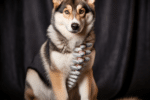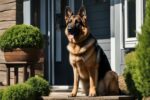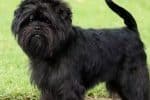Comprehensive Guide to Afghan Hound Characteristics and Care

The Afghan hound is an ancient dog breed that originated in the cold mountains of the Middle East, then its horizon was expanded to Afghanistan. The breed was first named tazi and is thought to date as far back as the Christian era. It has a graceful, long, and silky coat that protects it from extreme temperatures.
Originally bred by nomadic tribes to hunt rabbits, the Afghan hound energy level is high. It would require a home with a high fence and a spacious crate where they could get enough space to relax and rest. The Afghan hound is not suitable as an apartment dog. They may come in colors such as white, black, gold, and brown.
The Afghan hound would easily adapt to any home. They are affectionate and one of the best companions to have. You should ensure they get plenty of exercise and manage their energy levels well.
You should devote some time to maintaining their beautiful fur.
Characteristics
The Afghan hound’s traits are important to consider before adoption. They are affectionate with their families, sensitive to changes, and can be reserved with strangers. They get along well with other pets, have high energy levels, and require regular exercise. While they don’t drool much, their luxurious coat sheds frequently.
Despite their sensitivity, Afghan hounds are adaptable to various weather conditions, excelling in both cold and hot climates. They are not prone to weight gain, making exercise crucial. If shedding is a concern, consider another breed. The Afghan hound’s energy level is notably high due to their hunting background. While they may be reserved with strangers, early socialization can help moderate their temperament.
Size/Weight
Females weigh about 50 pounds and grow to about 25 inches tall.
A male weighs 60 pounds and grows to about 27 inches tall.
What is the Afghan hound life expectancy?
These breeds have limited genetic heath issues. With proper checkups and care Your Afghan hound lifespan is 10 to 12 years. They may exceed this expectation or live shorter. This is an average range.
History
The Afghan hound (original name; tazi) is an ancient domestic dog breed that has been around since 4000 B.C. when it stayed in the mountains of the Middle East. Hence, its name. British soldiers brought it to Britain in 1920. It was later introduced in America in 1926, where the breed was registered by the American Kennel Club.
These breeds are natural hunters. They were used in Pakistan and India by nomads who used them to take down both small and bigger animals such as rabbits and leopards by grabbing them on their necks, according to the American Kennel Club.
One of the Marx Brothers, Zeppo Marx, was one of the first to bring Afghan hounds to America. The Barbie movie in the late 1970s increased the popularity of the hound. As her pet hound, it found its way into the hearts and homes of many young American girls. The hounds’ involvement in the obedience competition and the development of the lure coursing competitions made the hound more appealing.
Feeding
We recommend feeding your dog 3 cups of high-quality dry food a day. You can divide and feed them twice a day. The daily cost of feeding your hound may range from $2.50 to $3.00.
It is important to note that the amount of food your dog eats depends on a few factors, such as his age, metabolism, size, and build. A highly active dog would need more food than a less active dog. Feeding your dog high-quality meals will nourish your dog, and that also means you will have to put less quantity into their bowls, saving yourself some cash.
Your hound can stay in good shape if you measure his food and feed him twice daily instead of leaving it out at all times. How can you know if your dog is becoming overweight? Give him the hands-on test and eye test. First, look down at him. You should be able to see its waist. Then place your hands on his back, thumbs along the spine, with the fingers spread downward. If you can’t feel its ribs without pressing hard, it needs more exercise and less food.
personality and behavior.
The Afghan hound is a good family dog that tolerates children (supervision is advised) and other pets, though they won’t play too much. They are like the older brothers who won’t go with the younger ones to play but will watch them instead. The hound may not join the kids or other pets to lay, but they won’t be hostile. They will chase any cat they see when they are out the door. It’s best to leave them on a leash. They would get violent with strangers. It is best to introduce them gradually to strangers.
They are quick to learn and exceptionally perceptive. If you leave them alone for too long, they may destroy your belongings. They have a rapid rate of learning and application.
Price of an Afghan hound
In searching for an Afghan hound for sale in the U.S or any other country, it is important to prioritize quality puppies. you don’t want to buy a dog who will fall sick regularly from bad breeding and wrong early care practices. Check reviews and do due diligence.
Afghan hounds puppy price in US goes from $600 to $1,000 . If you’re looking for a show dog, you may pay up to $2,500. Breeding rights and papers are typically pricey.
Afghan hound price in India ranges from ₹60,000 to ₹80,000. The law on pet quality is not strictly adhered to in India, do your due diligence.
Afghan hound cost in Australia will go anywhere from $1500 AUD to $3000 AUD. Quality of a dog doesn’t solely depend on pricing. Check the policies that guides the breeders existence.
A pedigree Afghan Hound puppy cost in the U.K upwards of £1000. You’ll also have to think about insurance, grooming, and food. You can home an Afghan Hound through a number of different rescue organizations.
Health issues
Afghans are generally healthy but will be susceptible to disease just like other breeds. Afghans won’t get all or any of these health issues. It is okay to be aware of likely diseases if you are planning to get one of the Afghans.
It is best to find a good breeder when buying a puppy. He should be able to provide you with health clearances to prove that the dos have been tested and cleared of common conditions. Clearance for elbow and hip dysplasia, von Willebrand’s disease, and hypothyroidism from the Orthopedic Foundation for Animals (OFA) is necessary. You can simply check (offa.org) to confirm the clearance.
Common health issues include:
- Allergies: They may sneeze, have nasal and eye discharge, itchy skin, and hair loss.
- Hypothyroidism is a disorder of the thyroid gland. Chronic bacterial infections of the skin, ear infections, lethargy, depression. This condition is treated with diets and medications.
- Juvenile cataracts: As defined by The Canine Eye Registration Foundation (CERF), “a cataract is a partial or complete opacity of the lens.” They also warn that this is the leading cause of loss of vision in dogs.
Care and Grooming
Afghans are laid-back and calm when inside the house. They prefer to stay inside the house. They will require daily exercises such as leash runs or walks.
A secure high fence is a must if you plan on keeping this hound in your yard. The Afghans (who may have watched Prison Break) are escape artists. If loose, they are hard to catch. Positive reinforcement methods and obedience training are best.
>>read more>> How To Care for, and Afghan Hound grooming
Coat Colors
The Afghan hound has a very fine texture that is similar to that of humans; it is silky and thick, with a silky topknot on its head. American kennel club standards allow the use of all solid colors.
The coat must be groomed regularly because of its considerable tangling potential. The Afghan should be regularly brushed and bathed. You may want to hire the services of a professional groomer, as it could take a long time to groom one. Your Afghan hound would require a consistent maintenance routine, including brushing and grooming at least once a week. This includes removing tangles and mats in the fur using a pin brush, toothed comb, and a slicker brush.
Good dental hygiene is necessary to remove the buildup of tartar and bacteria. Brush your Afghan teeth three times a week. If you trim their nails twice a month, your dog may wear them down naturally. If you can hear the nails clicking on the floor, it’s time to clip those nails.
Conclusion
Grooming is essential. If you don’t enjoy grooming or you cannot afford to pay a groomer, you may want to choose a different dog. An Afghan’s instinct to hunt would cause him to chase prey. If you intend to keep it in the yard, you’ll need a sturdy fence. As we always recommend, it is better to get a dog from a shelter home.








